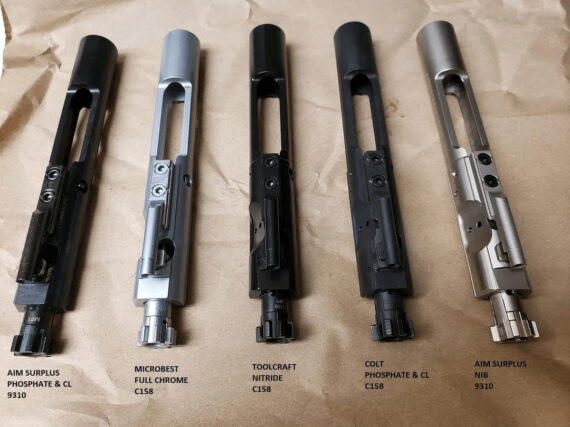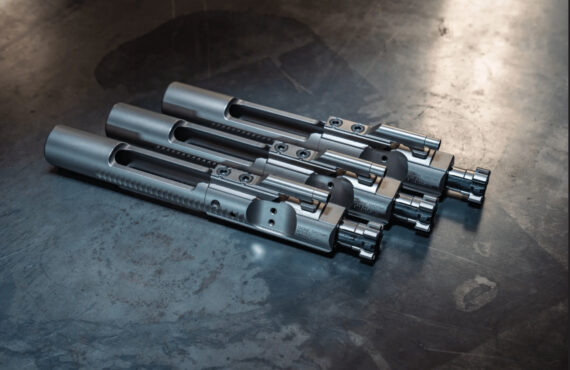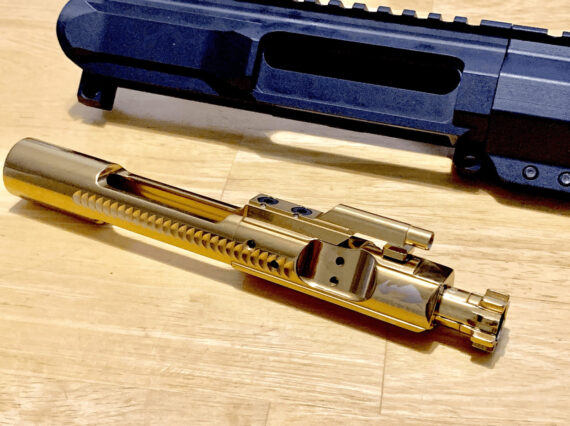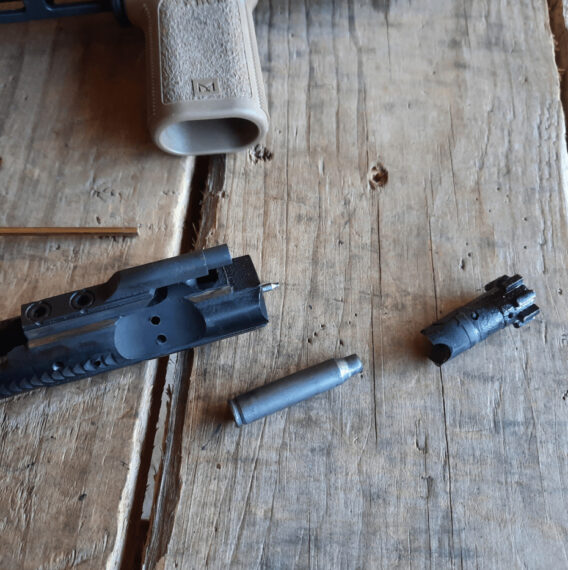Bolt Carrier Group Materials: Don’t Fall For The Hype
Bolt Carrier Groups (BCGs) come in a plethora of different materials. Unfortunately, not many shooters understand that the material of your BCG can make or break the reliability of your firearm.
This applies to the coatings and the material of the BCG itself. There’s a difference: the coating is an outer layer that helps with function or aesthetics, while the material is what the BCG is constructed of.
Although we’ll be ranking the different materials and coatings, that doesn’t mean you can’t get a bad apple. If you want to be extra careful, you can have your BCG gauged by a gunsmith. And, of course, you should always test your gear before relying on it.
Let’s dive into some materials and coatings.

After you read this, you’ll know which is the best. Source: reddit
Bolt Carrier Group Coatings Ranked (Best to Worst)
I’ve spent the past ten years learning everything I can about the AR-15, shot plenty, and researched a ton. These coatings are ranked from least to most problematic, which I and 13 other armorers have agreed on.
Chrome
This coating is loved for its lubricity (how slick it is) and ability to avoid corrosion. It’s a highly durable coating.
This is why manufacturers use chrome lining on the bolt carrier group’s high-wear points.
Typically, the companies that make chrome-coated bolt carrier groups have excellent quality control. Not all, but most. It’s the least problematic coating that we’ve used.
However, the extractor should be phosphate since chrome is too slick to reliably remove casings from the chamber.
Phosphate
Phosphate has a more rough surface than chrome, but not in ways that will chew up the insides of your upper receiver. The rough nature of phosphate makes lubrication stay in place.
Since it’s not slippery, grease will stay in place and not run off like chrome or NP3.
It doesn’t hedge against corrosion as well as chrome, but I’ve run plenty of phosphate BCGs and only had issues with corrosion when lubrication was sparse and I forgot to maintain them—other than that, it was never an issue.
When looking at a phosphate-coated bolt carrier group, make sure that the interior of the gas key and bore is chrome-lined. Phosphate is not a surface that likes constant friction.
NP3
Many companies make NP3-coated bolt carrier groups, but Scionics Weapon Systems was the first to do so. Again, any BCG can fail, but Scionics does it best with NP3.
Out of all the coatings on this list, NP3 is the best for lubricity, corrosion resistance, and heat resistance. NP3 impregnates the material with lubrication, making it a self-lubricator at operating temperatures. However, I’d still recommend a thin coating of grease on the carrier and the inside of the upper receiver.
When it comes to coatings, nothing is more corrosion-resistant than NP3. I’ve heard of shooters leaving rifles wide open to the elements for days. Their bolt carrier group never showed wear, but the rifle had seen better days.
Since NP3 is so slick, you want to ensure the extractor is phosphate-coated to prevent the extractor from slipping off the case’s rim after firing.

NP3 coated BCGs from Triarc Systems. Source: reddit
Nano-coated/DLC
Now, we’re entering the more problematic coatings.
Remember, not all of these bolt carrier groups will be bad, but they tend to have more issues and problems wearing.
This can be anything from the bolt showing wear relatively early in its lifespan to parts like the lugs (or teeth) on the bolt key wearing quickly. Tolerance issues, when the spacing between parts is too far or too close, are also a considerable issue seen with most manufacturers who use DLC as a coating.
Nitride Treated
Nitride is not a coating but a treatment. It’s a different process, but the aim is the same. But there’s a problem with that.
Nitride-treated bolt carrier groups are ridden with tolerance issues, specifically in the area where the bolt resides.
We’ve also seen quality control issues with nitride-treated bolt carriers where the gas key screws will be improperly staked. If you don’t know, the gas key screws should be staked in the center. This is standard practice.
Be extra careful with nitride-treated BCGs.
PVD/TiN
PVD stands for Physical Vapor Deposition, a process that adds a thin layer of material to the surface. TiN, or Titanium Nitride, is a PVD coating.
The issue with PVD-coated bolt carrier groups is that the companies that make them typically focus solely on the outside aesthetics without realizing how terrible the PVD coating is for the inside of the bolt carrier group.
These same companies typically won’t bother with chrome lining, either. PVD/TiN is cheap, so you can expect cheap results. Unless it’s chrome, stay away from the shiny stuff.

Looks are less important than function. Source: reddit
Nickel Boron (NiB)
At one point, AR-15 enthusiasts thought NiB was among the best coatings you could get. But we were wrong. NiB bolt carrier groups have given us the most problems from any other coating on this list.
Like anything else, NiB has potential; it’s the manufacturers who give it a bad rap. I’ve seen a few good apples, but typically, NiB BCGs have many issues with tolerances on every front.
Unfortunately, the amount of issues often seen puts NiB in dead last.
Best Bolt Carrier Group Materials Ranked (Best to Worst)
Carpenter 158
Carpenter 158 is not a standard steel. It’s a chrome nickel alloy steel that is softer in the center, but the process of making Carpenter 158 makes the outer layers the hardest of any material used to make bolt carrier groups.
Since it’s more flexible towards the center, it absorbs shock far better than the other steels, which gives the shooter a more manageable and less violent recoil.
It’s also the most expensive material, so expect the rest below this one to be more affordable.
9310 Steel
9310 steel is for the hardest uses where one doesn’t care about less recoil; they just want a bolt carrier group that will run and not break. You often find that bolt carrier groups for automatic or three-round burst rifles are made of 9310 steel.
That’s because 9310 steel is harder than Carpenter 158 throughout. There may be more felt recoil, but that’s, of course, due to the slightly heavier weight reciprocating backward.
These are excellent bolt carrier groups, and they aren’t cheap, either.
8620 Steel
8620 steel is good ol’ mil-spec, which means it’s the bare minimum regarding your rifle needs. It’s not bad, but it’s nothing to write home about. It’s softer than 9310 and Carpenter 158, with 9310 being about 8% stronger in all categories.
If you’re running a mil-spec BCG, it’s likely made of 8620 steel with either a 9310 or Carpenter 158 bolt.
If you’re building a rifle for hard use, always ensure your bolt is made of 9310 or Carpenter 158. 8620 bolts break far more often, and getting a bolt made from one of the other materials will be cheaper in the long run.

Don’t be fooled; any material will fail eventually. Source: reddit
Conclusion
Okay, let’s wrap all of that information up. If you asked me right now what you should be running, I’d say a 9310 or Carpenter 158 BCG with any of the first three coatings.
All of these coatings and materials can fail, so I recommend getting your bolt carrier group from a reputable company and then having it gauged by an armorer. Also, make sure it works with your rifle efficiently. Always test your gear thoroughly in case your life ever depends on it.
Be good and take care.